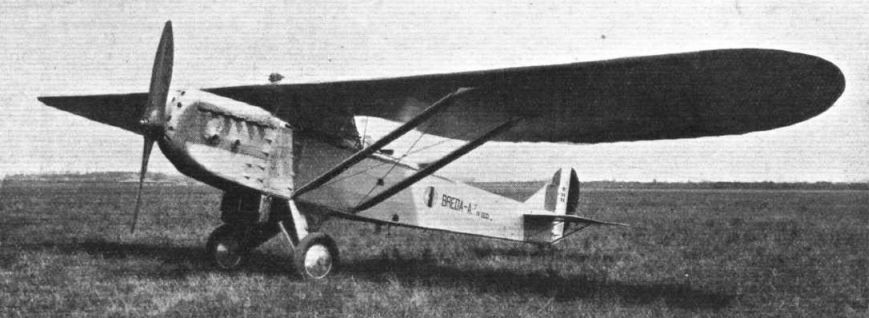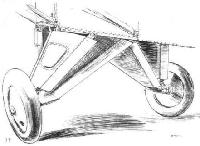Breda А.7
Самолет А.7 LD был подкосным монопланом с крылом типа парасоль, двухместной кабиной и неубирающимся шасси. Собрали два прототипа с двигателями Lorraine-Dietrich мощностью 400 л. с. (298 кВт). За ними последовали 12 серийных машин, поступивших на вооружение разведывательных частей ВВС Италии в 1929 году. На серийные А.7 ставили моторы Isotta-Fraschini Asso.
Варианты
А.16: первоначально известный как А.7 Raid (большой дальности). Это был двухместный моноплан для дальней разведки, оснащенный двигателем Asso 500 AQ. Позже его переделали в трехместный со звездообразным мотором Bristol Jupiter VII и четырехлопастным винтом. На вооружение принят не был
ТАКТИКО-ТЕХНИЧЕСКИЕ ХАРАКТЕРИСТИКИ
Breda А.7 Asso
Тип: двухместный разведывательный самолет
Силовая установка: V-образный двигатель Isotta-Fraschini Asso, мощностью 510 л. с. (380 кВт)
Скоростные характеристики: максимальная скорость 235 км/ч на оптимальной высоте; крейсерская скорость 175 км/ч; набор высоты 2000 м за 7 мин 11 с; практический потолок 6500 м; радиус действия 1200 км
Масса: пустого самолета 1500 кг; максимальная взлетная 2500 кг
Размеры: размах крыла 15,18 м; длина 9,22 м; высота 3,14 м; площадь крыла 43,00 м2
Вооружение: подвижный пулемет Lewis калибра 7,7-мм в задней кабине
Показать полностьюShow all
Flight, March 1928
THE BREDA A.7 MONOPLANE
A Successful Italian Military Machine
ALTHOUGH now one of the largest aircraft constructing firms in Italy, the Societa Italiana Ernesto Breda, of Milan, is not, perhaps, so well known in this capacity to our British readers as some of the other Italian and Continental aircraft concerns. We are glad, therefore, to be able this week to give a brief description of one of the latest Breda products, which has, we understand, given very satisfactory results in Italy.
It might be as well before proceeding with our description to say a few words regarding the Breda firm itself. An old-established Italian engineering company in pre-war days, S.I.E. Breda, during the Great War produced large quantities of aircraft parts and accessories. It also built Caproni machines and Isotta Fraschini aero engines.
After the war the Breda firm produced a number of experimental machines of its own design, some of which were of more than usual interest, and were very successful. Subsequently it took up the problem of metal construction, and designed some all-metal machines which gave very satisfactory results.
Besides the construction of aircraft, the Breda firm also runs a highly efficient school of flying, about which we hope to have something further to say on a future occasion.
The Breda A.7 - the machine we are about to describe - is a 2-seater high-wing (or "Parasol") "semi-cantilever" monoplane, a type particularly suitable for reconnaissance work, for which it was designed. Except for the fabric covering of the planes and fuselage, the A.7 is entirely of metal (steel and duralumin) construction.
The wings possess several interesting features; they have a very efficient section of medium thickness, and vary as regards the latter from maximum at a point about midway out from the root to a minimum at the tips and root. They are supported above the fuselage on a cabane consisting of two inverted V struts, while a pair of bracing struts on either side extend from the lower longerons of the fuselage up to the wings, where they are attached at the point of maximum thickness. These struts consist of steel tubes, with streamline fairings.
Constructionally the A.7 wings are exceptionally strong and rigid, thorough tests having been carried out with the first experimental machine, resulting in many modifications and improvements. For instance, instead of wooden spars, these are now constructed of steel, in lattice form, the flanges and webs being of sheet-steel cold-pressed to the required sections. The transverse members are also of pressed steel, and are riveted to the main spars.
The ribs are of duralumin, and abut against the front spar; the leading edge forms a separate unit, complete with framework and metal covering, attached to the front spar - thus forming a large single casing. It is claimed for this form of construction that a very strong and rigid structure is obtained, especially in the matter of torsional stresses. The A.7 wing is capable of withstanding any form of stunting.
A portion of the trailing edge of the plane is cut away at the centre, above the pilot's cockpit, in order to provide an unobstructed view upwards. The ailerons are of fairly large proportions, extending for nearly half the length of each wing, and thus render the machine very manoeuvrable. Lateral control is further facilitated by the provision of small auxiliary balancing surfaces mounted on the ailerons. The rudder and elevators are also balanced.
The fuselage of the A.7, which is of rectangular cross-section, is constructed entirely of steel, also from pressed sheet, riveted together, being built up of longitudinal and numerous transverse members. The pilot's cockpit, which is very comfortable, is situated below the trailing edge of the 'plane, and immediately behind is the observer's cockpit. Both are provided with controls - the joystick in the observer's cockpit being removable - while the pilot's dashboard, containing a full range of instruments, is placed so as to give easy reading of the latter.
In the pilot's cockpit, also, is a self-starter for the engine, while a small wheel close at hand enables the incidence of the tail plane to be adjusted during flight.
The 500 h.p. Isotta Fraschini engine and its steel mounting forms a separate and detachable unit, being secured by four bolts and thus providing for quick and easy changing of the power plant. The whole engine is completely enclosed in a neat metal housing, the radiator being slung beneath the fuselage. Sufficient fuel is carried for a flight of seven hours.
The landing gear is another distinctive feature of the Breda A.7, being of the non-axle type constructed of riveted sheet steel. Each wheel is carried by two enclosed V’s, the shock absorbers, which are particularly soft in action, being contained within the outer V’s.
The A.7 is easily converted from a land machine into a seaplane by fitting two floats in place of the wheels. The first machine of this type was recently tested at the Breda factory at Mestre (Venice), and gave good results both as a land-plane and seaplane.
The principal characteristics of the Breda A.7 are :-
Span 51 ft. 9 in.
Overall length 34 ft. 6 in.
Wing area 462 sq. ft.
Weight empty 3,440 lbs.
Useful load 1,984-5 lbs.
Total weight 5,424-5 lbs.
Weight per square foot 11-68 lbs.
Weight per horse-power 10-87 lbs.
Safety factor 10-5
Speed range 46-5-152-25 m p.h.
Climb to 16,400 ft. 23 mins.
Service ceiling 24,607 ft.
"Everling Quantities" (Metric)
High-speed figure 23
Distance figure (top speed) 4-5
Altitude figure (ceiling) 8-5
Показать полностьюShow all





